Log in or Sign up
You are using an out of date browser. It may not display this or other websites correctly. You should upgrade or use an alternative browser .

How many settings on a Phaser
Discussion in ' Trek Tech ' started by JT Perfecthair , Sep 25, 2013 .
JT Perfecthair Lieutenant Commander Red Shirt
I'm not sure if I'm remembering from the Franz Joseph tech manual or some other early Trek book but I recall a phaser having various settings: Stun: make a living thing dazed Heavy stun: make a living thing unconscious Kill: make a living thing die Heat: speeds up molecules, things get hot Disrupt: separates molecules, blows things up Dematerialize: energizes molecules, make things vaporize Also used during TOS were a wide stun beam for dealing with a crowd and an invisible cutting beam. There is also one use of a stun setting on the ship mounted phaser banks. I'm not clear on whether the phaser is just outputting varying power levels of the same energy beam or is each setting a different beam or stream of different particles? What other or different settings do you think were on the TOS phasers and how did the later series or movies differ?
Shawnster Rear Admiral Rear Admiral
I believe you're correct (or, at least, we've read the same list somewhere). However, I have a question as to the abilities of some of these settings. What would the heat setting do to living tissue? Those rocks in "A Private Little War" looked to be glowing pretty hot. Perhaps Heat and Kill are the same? Could the invisible cutting beam be one of these other settings like disrupt, only with a narrow focused beam?
Mark_Nguyen Rear Admiral Rear Admiral
Known settings listed here. Not surprisingly, especially early on they didn't have a uniform way of describing phaser power levels: http://en.memory-alpha.org/wiki/Phaser Mark
JarodRussell Vice Admiral Admiral
1. Stun 2. Kill 3. Plot
MacLeod Admiral Admiral
Well if you go buy the TNG Technical manual, they are 16 settings. Shame by the 24th Century they have forgotten ships phasers can be set to stun.
Maurice Snagglepussed Admiral
Turn it up to 11.
PhoenixClass Lieutenant Commander Red Shirt
Don't know about TOS phasers, but per the TNG Tech Manual, the little phasers, Type I, that fit in the palm of your hand, go from 1 to 8. Type II, which are little larger and we see more often, go from 1 to 16. The Type III rifles are similar to the II but with a greater power reserve. There are also variants of Type I that are limited to setting 3, heavy stun.
Duncan MacLeod Fleet Captain Fleet Captain
I used to use these setting for FASA's Star Trek RPG Settings # setting description 1 Light Stun 50 pts. non-lethal (n-l) damage, subject will be unconscious for about a minute and semi-conscious for 1D4 minutes more. 2 Stun 75 pts. n-l, subject is unconscious for 4 + 1D6 minutes. 3 Heavy Stun 120 pts. n-l, subject is unconscious for 30 + 3D10 minutes. 4 Heat I 30 pts. lethal (l) damage, will heat objects to 150 degrees C. 5 Heat II 60 pts. l, will heat objects to 300 degrees C. 6 Disrupt A 90 pts. l, will cause an exit wound, will bore through rock at 9 cm. per shot. 7 Disrupt B 150 pts. l, disintegration threshold (DT) of organic matter will atomize up to 35 kg. will bore through 15 cm. of rock 8 Disintegrate 250 pts. l, DT of rock and light metals will atomize 100 kg. 9 Structural I 350 pts. l, will bore through 3.5 cm. of rodinium alloy per shot, will atomize 175 kg. of rock 10 Structural II 500 pts. l, will bore through 5 cm. of rodinium alloy and atomize 250 kg of rock, DT of boron steel will atomize 25 kg. 11 Structural III 1000 pts. l, DT of adaman alloy will atomize 25 kg. also 50 kg. of boron steel and 500 kg. of rock, will bore through up to 10 cm. of rodinium alloy per shot. 12 Structural IV 2000 pts. l, DT of trititanium alloy will atomize 20 kg., will atomize rock by the ton, houses will be vaporized, will penetrate up to 20 cm. of rodinium alloy. 13 Structural V 5000 pts. l, will atomize 75 kg. of trititanium alloy, 500 kg. of boron steel, 150 kg of adaman alloy and any natural physical object up to 5 tons that is not force field protected. DT of rodinium alloy will atomize 15 kg. Power Drain Setting # Power Drain 1 1 kw 2 2 kw 3 4 kw 4 8 kw 5 16 kw 6 32 kw 7 64 kw 8 128 kw 9 256 kw 10 512 kw 11 1 mw 12 2 mw 13 4 mw Power Packs and Max Settings Phaser Years Power Pack (kw) Maximum Setting II-X (early pistol phaser) 2250-2260 3000 10 III-X (early rifle phaser) 2255-2275 9000 11 I-A (TV hand phaser) 2260-2279 1500 7 II-A (TV pistol phaser) 2260-2279 5500 11 I-B (ST-TMP, 2 hand phaser) 2277-2288 2000 8 II-B (ST-TMP, 2 pistol phaser) 2277-2288 6000 12 I-C (ST 3, 4 hand phaser) 2285-2335 2500 8 II-C (ST 3, 4 pistol phaser) 2285-2335 7500 12 III-C (ST 5 rifle phaser) 2285-2335 15000 13 II-CS (ST 5, 6 assault phaser pistol) 2286-2350 7500 13 Ranges and Overload Phaser Ranges PB/S/M/L/X (meters) Overload Radius (meters) II-X 3/15/40/100/160 40 III-X 10/50/150/300/500 150 I-A 1.5/10/24/60/100 24 II-A 3/20/50/120/200 50 I-B 1.5/12/30/70/120 30 II-B 3/30/70/120/250 70 I-C 1.5/12/30/80/130 30 II-C 3/30/80/130/300 80 III-C 12/60/180/360/600 180 II-CS 3/40/80/130/300 80
bbjeg Admiral Admiral
I thought there were infinite settings and ranges.
T'Girl Vice Admiral Admiral
Don't forget the best setting of all, make a lot of noise and then blow up.
Boris Skrbic Commodore Commodore
I'm sure Data can change a TNG phaser setting instantly and accurately, but what about everyone else? Do they listen for the number of beeps? Do they count the tiny lights? A simple numeric display would've been easier to use.
Well, in TNG anyway there's a grand total of TWO BUTTONS plus the trigger. As such, I'd wager Starfleet has a fairly intuitive user interface such that anyone trained in its use could change the settings as needed for most foreseeable situations. For everything else, you pop the lid and fiddle with the insides, as we've seen done on at least one occasion. Mark
I'm saying that a mini-Okudagram showing "16" or "9" or "1" would've been easier to read (though not as easy to implement in prop form using 1980s technology).
Saturn0660 Rear Admiral Rear Admiral
I get the feeling that the buttons "buzz" just a bit when you touch them so you know you pushed it..
But how could you get that feeling, seeing as you couldn't have held them down yourself? Moreover, I don't recall any onscreen dialogue to that effect (I didn't see much of VOY or ENT, though).
Boris said: ↑ But how could you get that feeling, seeing as you couldn't have held them down yourself? (I didn't see much of VOY or ENT, though). Click to expand...
I mean that because you've watched the series, you must have heard the mini-beeps accompanying a change in setting and seen the changing rows of green lights, but anything else is unnecessary speculation, unless you can quote a piece of dialogue regarding vibration. There is enough feedback to show that a setting was changed to some value; I'm just wondering why the user should be required to count the beeps or the lights, rather than have a look at a mini-readout saying "16". The cheapest clock can have it, so why not a phaser?
publiusr Admiral Admiral
A few function settings. On pure cutting you dial the knob for more finite adjustments.
- Log in with Facebook
- No, create an account now.
- Yes, my password is:
- Forgot your password?
- Search titles only
Separate names with a comma.
- Search this thread only
- Display results as threads
Useful Searches
- Recent Posts
- Celebrities
- Secret Invasion
- The Marvels
- Disney Plus
- Apple TV Plus
- Dwayne Johnson
- Brie Larson
- Ryan Reynolds
- The Witcher
- About & Advertising
- Privacy Policy
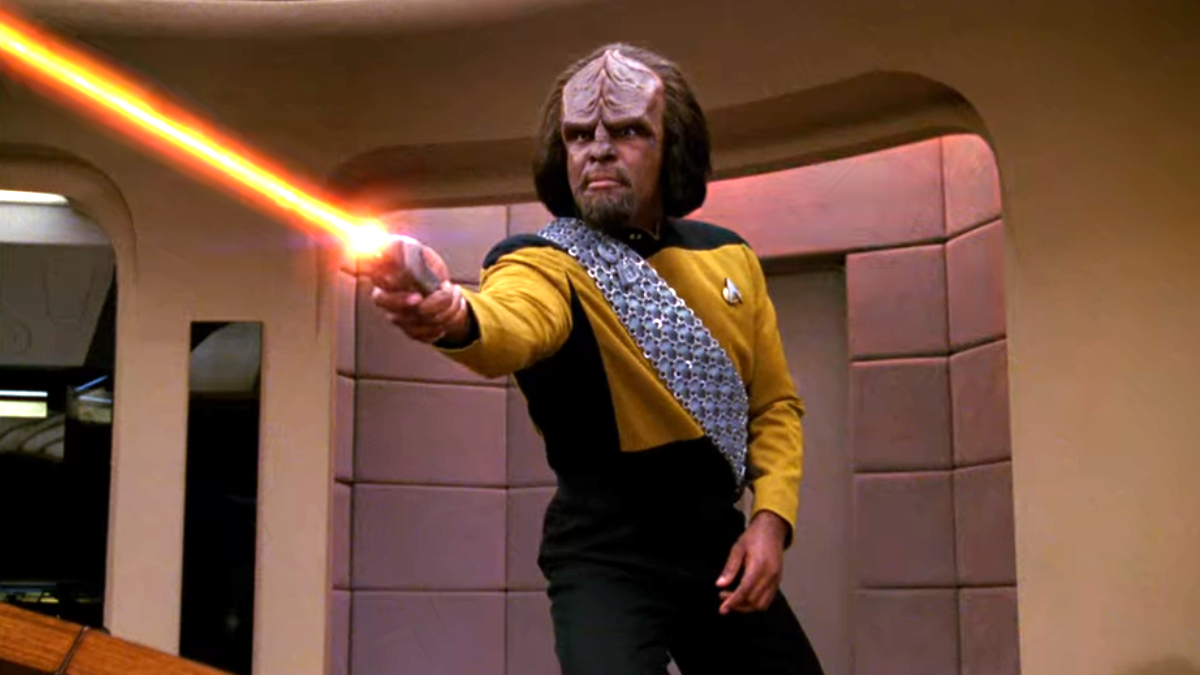
Set phasers to fun: All the ‘Star Trek’ phasers, explained
The phrase “set phasers to stun” has earned its place in popular culture, and Starfleet’s iconic weaponry has been a crucial part of the setting ever since The Original Series , but just what are the specifics of these incredible weapons?
In each Star Trek series, Starfleet crews primarily use hand phasers. The Type-1 phaser is a small handheld device capable of various settings, including numerous degrees of stun, kill, and heat. In The Original Series , the Type-2 was a pistol-like receptacle in which the Type-1 could be fitted, amplifying its power. By the time of The Next Generation , the Type-1 and Type-2 were entirely separate devices, with the Type-2 having a far sleeker design.
While the “kill” settings on a phaser can turn it into a highly destructive weapon capable of vaporizing a target, standard Starfleet rules of engagement are to have phasers always set to some form of “stun,” unless explicitly ordered otherwise. The stun setting is able to render most targets unconscious with no permanent injury, making it ideal for Starfleet’s ethos of peaceful exploration.
On rare occasions, Starfleet officers may be equipped with the Type-3 phaser rifle, a much larger and longer variant of the phaser held with both hands. The Type-3 is said to be capable of even more powerful shots than the Type-2, though still has a range of stun settings.
The width of the beam of any type of phaser can also be modified, making a single phaser highly effective against large crowds. Even the Enterprise’s phasers can be set to stun – in the Original Series episode “A Piece of the Action,” Kirk orders the Enterprise to prevent a shootout between two factions of aliens by firing a wide-beam stun from orbit, knocking out entire streets of people.
Non-combat uses
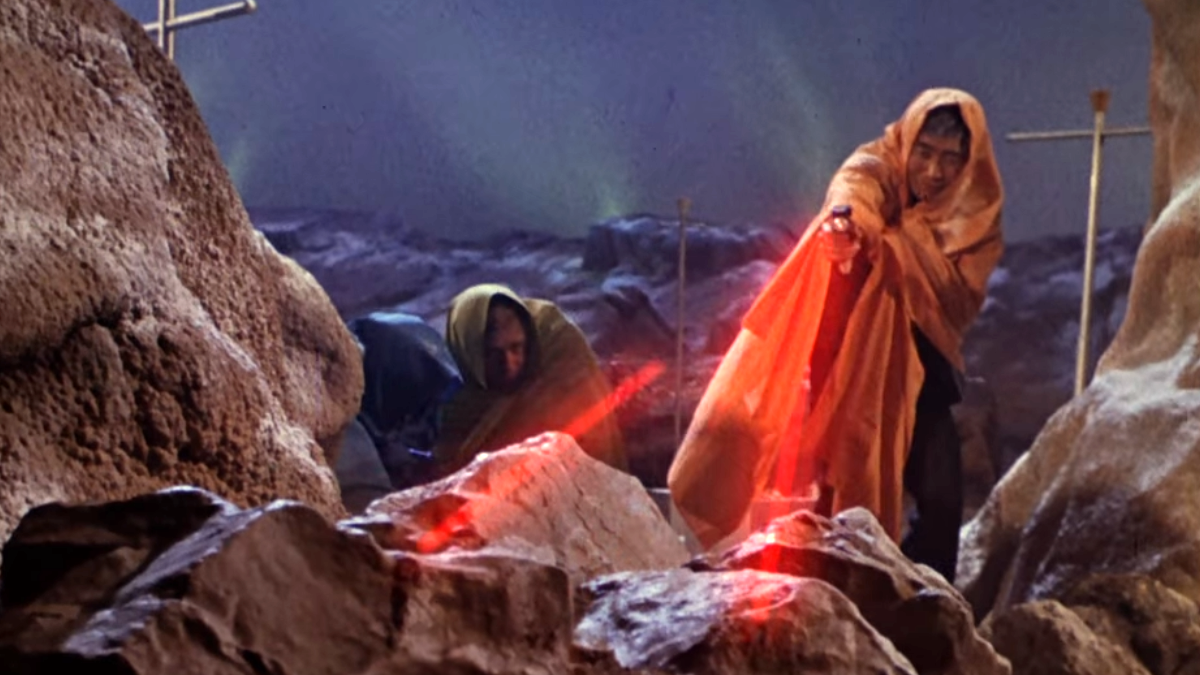
In The Original Series ,Type-2 phasers could also be set to “overload.” The damage caused by this could be catastrophic, as a single phaser on overload aboard a ship could generate a blast capable of destroying part of the hull and exposing an entire deck to space. In the episode “The Conscience of the King,” Kirk and Spock narrowly avoid this fate when an assassin hides a phaser on overload in Kirk’s quarters, leading to the only instance in Star Trek history of a “double red alert.”
Phasers had various non-forceful applications too – in The Original Series’ “The Enemy Within,” Sulu uses a phaser to heat a rock, turning it into a radiator and saving the lives of his team who are stranded in icy conditions. In The Next Generation ’s “Silicon Avatar,” Riker uses a phaser to seal a cave entrance to protect sheltering refugees from an attack.
In all their forms, phasers are an iconic part of Star Trek , giving writers plenty of ways to have the heroes overcome hostile alien encounters without the need for lethal violence.


Type-1 phaser
- View history
A type-1 phaser was the smallest, most basic weapon carried by Starfleet and other Federation personnel. Type 1 phasers were typically carried when it would be inappropriate to carry a larger weapon, such as on diplomatic missions, or "undercover" work.
The type 1 had eight adjustable settings, ranging from stun to heat through disruption to disintegration. The 23rd century type 1, in use in the 2260s , incorporated a small flip-up sight . ( TOS : " A Private Little War ") Several versions of the type 2 phaser incorporated a type 1 phaser into their design.
A 23rd century type 1 phaser did not possess sufficient power to harm a silicon -based lifeform , such as a Horta . ( TOS : " The Devil in the Dark ")
24th century type-1s could be programmed to fire automatically at set intervals. ( TNG : " The Game ")
By the 2380s , type 1s had gone through a form factor change, giving them a streamlined grip that was more reminiscent of late 24th century type 2 phasers . ( PRO : " Dream Catcher ")
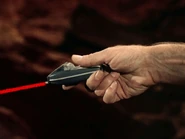
Background information [ ]
The Star Trek: The Original Series type 1 phaser, as the designation was first identified on screen in TOS : " The Devil in the Dark ", was designed by Matt Jefferies and John Jefferies with input from Gene Roddenberry , and was built (or the construction supervised by him at the Desilu prop shop) by Matt Jefferies, and later modified by Wah Chang at Gene Roddenberry's request. It is a common misconception that Chang, the builder of both the tricorders and communicators, also built the phasers. Roddenberry was unhappy with how the black and white phasers registered on screen and so asked Chang to give them a new paint scheme and add some detail. The new grey paint scheme and details on the "hero" phasers were seen in the episode "Dagger of the Mind". This is based on interviews with Jefferies' brother and an interview by propmaster Alan Sims (HMS) with Chang and backed up by copies of the invoices Chang submitted to Desilu for his work of "refurbishing" the phasers.
On Sunday, 27 September 2009 , the Art Directors Guild Film Society presented a panel discussion titled " Star Trek : 45 Years of Designing the Future" in which the participants were John Jefferies, Joseph R. Jennings , Herman Zimmerman , and Scott Chambliss . During this panel discussion, John Jefferies said that the design of the TOS phaser was a joint effort between himself, his brother Matt Jefferies, and Gene Roddenberry. According to John Jefferies, he was hired to work on the design of the phaser as an independent contractor, since he was still working for Columbia Pictures at the time, and hence was not part of the regular Star Trek Art Department. After discussing design ideas with Matt Jefferies and Gene Roddenberry, John drew five drawings of possible designs for the phaser. About a week later, he showed the drawings to Matt Jefferies and Gene Roddenberry. They chose elements from each of the drawings and asked him to combine them into one, which ended up being the design of the first phaser prop. John Jefferies also mentioned that the basic shape of the hand phaser was inspired by a remote control that Magnovox had recently released.
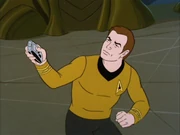
Variant type-1 phaser with reversed coloring
The sight is not immediately apparent in most episodes, but a detailed physical examination of one of the surviving "hero" phasers has documented its presence, as well as the location of the trigger. ( TOS Season 3, Disc 7 "A Star Trek Collector's Dream Come True") ( Star Trek: Communicator ( citation needed • edit ) )
In Star Trek: The Animated Series , type-1 phasers were seen with their coloring reversed: They were silver/grey with black trimming.
In Star Trek: Discovery , Starfleet personnel were equipped with a Type 1 phaser, Mk. 3. The specifications for this phaser type were revealed on the official Star Trek: Discovery Twitter account on February 26, 2018. [1]
The Star Trek: The Next Generation type-1 phaser was shown as having a completed design in a series of sketches which were dated 6 February 1987 and which Andrew Probert prepared for construction bidders interested in building the props required for the show. ( Star Trek: The Next Generation Companion (3rd ed., p. 11)) The TNG type-1 phaser was, however, designed by Rick Sternbach . A design patent was issued for Sternbach's design wherein he was identified as its "inventor". Nicknamed the "Cricket", the type-1 was rarely used after the first season of The Next Generation because Gene Roddenberry felt it was so minuscule that it was hardly visible on screen. ( Star Trek: The Next Generation - The Continuing Mission ) Nonetheless, it later appeared in " A Matter Of Honor ", " The Mind's Eye ", " The Game ", and " In the Flesh ".
Star Trek: How Do Phasers Work?

Your changes have been saved
Email Is sent
Please verify your email address.
You’ve reached your account maximum for followed topics.
The Legend of Zelda Movie Needs To Get One Big Thing Right
How the fallout tv show honors vats, x-men '97: 6 things it teases for season 2.
In the world of Star Trek, there can be found a plethora of incredible science fiction technology. Innovations range from warp drives that bend space to allow faster-than-light travel , all the way to the replication of food and drink from light. But while many of these technologies are used primarily for science, exploration, or recreation, the standard issue Starfleet Phasers are creations of attack and defense. So how exactly do these laser beam firing devices work?
At first glance, these weapons seem fairly simple in their application. They can stun an opponent in defense, or on the rare occasion, kill. However, they are interesting as they are far more multipurpose than they appear. Over the years, they have become somewhat of a Starfleet officer's multi tool. They can not only incapacitate enemies, but the technology is also used for a variety of purposes. They are able to melt metals together, heat things up, and even create artwork: burning marks onto canvas with precision.
RELATED: Star Trek: How Does Holodeck Technology Work?
The Weapon Of Starfleet
In terms of their destructive power, as phasers are used mainly as weapons, they are capable of a wide variety of things. On a low setting, they can be used to stun. Depending on the exact level of power the user specifies, this can mean anything from throwing a person backwards to knocking them out completely. A mighty Klingon , for example would be able to withstand a much higher degree of power from a phaser than a human would.
The stun setting on a phaser seems to be an impressive piece of technology . Trained officers must fine tune them to create the desired effect, much like an officer of today knowing the degree of electrical charade to pulse through a taser. On a high setting, these tiny devices are capable of large scale destruction. They can be used to kill, but also completely disintegrate a person if the setting was put high enough, rendering them to Endgame style dust . In the shows, they are suggested to be able to destroy buildings. Commander Data showcases this in the Season 3 The Next Generation episode "Ensigns of Command," where he uses a phaser to destroy an aqueduct.
In addition to their ability to vary their potential destructive capabilities, phasers can also vary their precision. These pocket-sized devices use particles instead of the more traditional energy, or ‘laser beam’ technology. As such, they rely on wavelengths to produces their desired effect. These wavelengths can be altered by the user, much like how a disruptor or works, producing a wave that can affect either a small or large area. This allows the user to aim at very specific targets without affecting anything around it. Phasers are precise enough for a protagonist to cross the line and completely disintegrate a person, without harming those standing directly next to them.
The Creation & Philosophy Of The Phaser
The devices were created, like many other Star Trek technologies, at last minute and with little explanation of how they worked. Rather, the technical details were added as the show developed over time. This is no criticism of The Original Series , as many other shows at the time functioned similarly due to time or budget restrains. When the creators were first fleshing out the idea, the producers had the cast carry what were essentially tranquilizer b-b guns, which would shoot small sedative pellets. This quickly proved to be a terrible idea, as the pellets were stopped by even the most primitive of armor or even clothing. They required skin contact to work (or at least make sense), so the producers chose to make them lasers.
Laser weapons were not only visually interesting, but also made sense for the these futuristic explorers. The issue, however, was that a laser was just as lethal as a gun. Roddenberry wanted the show to highlight his utopian vision of a future that favors peace over violence ( despite Starfleet ultimately being the Federation's Military ). To resolve this, he created a laser that could vary its power. Like many things in Star Trek, there was no real science behind this, at least at the start. Writers later scrambled to try and explain how this could work. They came up with the idea of a particle known as a nadion, and the complex science behind the phasers was born. One technical manual within canon gives the following explanation, and even then the majority of it is technobabble with no further explanation:
‘The Phaser (or the Phased Energy Rectification) uses the Rapid Nadion Effect to transfer and liberate strong nuclear forces through a super-conducting crystal. After this, the energy then passes through a Kawamura-Franklin Circuit, which then monopolarically phases it.’
Phasers have become a staple of the show ever since their introduction. They are both a device of violence, as well as a symbol of a more peaceful future for humanity . While soldiers of today are given guns whose only purpose is to kill, a phaser is a much better alternative. It is able to kill only when necessary, while also providing non-lethal means to incapacitate a foe. It is used as a form of defense, rather than offense. While the technical mechanics of the device have never been fleshed out (and seem to vary from show to show) their core message is a good one. There are always alternatives to killing, something Star Trek holds as one of its core messages.
MORE: Star Trek: Who Was Lwaxana Troi?
How Do Replicators Work?
Game rant's ultimate sci-fi guide, star trek has one problem with women in power.
- Movies & TV
Screen Rant
Star trek finally remembered that phasers aren't just for killing.

Your changes have been saved
Email Is sent
Please verify your email address.
You’ve reached your account maximum for followed topics.
9 Versions Of The Borg In Star Trek
Star trek's new warp drive makes all others look pathetic (in any era), star trek’s redshirt has a real world meaning.
The phaser is the most common and effective weapon in Star Trek but Star Trek: Lower Decks finally remembered that the handheld phaser is also a versatile tool and not just an implement of killing. CBS All-Access' animated comedy series has lovingly referenced and parodied the entire Star Trek franchise of both TV shows and films while the scrappy underdogs who make up the crew of the U.S.S. Cerritos have simultaneously defined Star Trek: Lower Decks ' own unique identity. The writers led by series creator Mike McMahan clearly love and understand Star Trek and, in the case of the phaser, they also have reminded fans that the ingenious tech is more than just a weapon.
Star Trek 's 23rd and 24th-century phaser technology evolved from the phase-pistol and phase-cannons of the 22nd century, which is what the crew of Captain Jonathan Archer's (Scott Bakula) NX-01 Enterprise were armed with. Along with photon torpedoes, phaser banks are starships' primary weapons while handheld phasers are sidearms used by Starfleet Officers on Away missions. The pistol-shaped phasers of Star Trek: The Original Series ' 23rd-century era gave way to the three most common types of phasers used in Star Trek: The Next Generation 's 24th-century time period: the Type-1 or hand phaser, the Type-2 phaser, which was larger and has a pistol grip, and the Type-3 phaser or phaser rifle used during heavy-duty combat. Star Trek has showcased innumerable phaser battles throughout the franchise, and Trekkers are familiar with "setting phasers to stun" an enemy and also, "setting phasers to kill" , which often involves the total disintegration of a target.
Related: Star Trek: Why Some Starfleet Officers Think The Enterprise Is Bad
But in Star Trek: Lower Decks , the crew of the Cerritos use phasers for all manner of jobs as well. This is because the phaser is actually a handy multi-tool. Using the phaser's different settings, the device can also emit a heat beam that has several useful applications; for instance, when stranded on an Away mission, the phaser can be used to heat food and drinks or heat rocks for warmth. Phasers can also cut through metal and rocks to create doorways. In Star Trek: Lower Decks , Ensign Beckett Mariner (Tawny Newsome) and her crewmates are seen performing carbon filter maintenance and using the phaser to remove sludge. Ensign Brad Boimler (Jack Quaid) even uses his phaser to remove graffiti from the Cerritos ' walls. With this in mind, it makes sense that the crew of the Cerritos is commonly seen hefting phasers in their daily duties even when the ship isn't on red alert and there's no enemy to fight.
Star Trek has often underlined just how dangerous phasers can be. In TOS ' classic "The City on the Edge of Forever", when Dr. Leonard McCoy (DeForrest Kelley) time-traveled to 1930s New York City, a homeless man got ahold of his hand phaser and accidentally disintegrated himself. In the TOS ' episode "The Conscience of the King", a phaser was set to self-destruct, which was not only meant to assassinate Captain James T. Kirk (William Shatner) but the explosion would have severely damaged the Starship Enterprise . In Star Trek VI: The Undiscovered Country , Lt. Valeris (Kim Cattrall) reminded the crew that no one may fire an unauthorized phaser aboard a starship because it signals a red alert. In addition, firing a phaser set to stun at close range has proven to kill a target.
When the TNG and J.J. Abrams' Star Trek films focused more on being action movies, the phaser was boiled down to its primary use as a weapon for shootouts with the Borg, the Romulans, and the Klingons. The TV series that followed, Star Trek: Discovery and Star Trek: Picard, also largely followed suit when they staged their spectacular action sequences. However, Star Trek: Lower Decks hews closer to the classic TNG style where the Cerritos engages in all kinds of missions in the final frontier while also highlighting the day-to-day drudgery of the Lower Deckers (which they mostly enjoy), and one of the benefits for longtime Trekkers is enjoying how Star Trek: Lower Decks showcases the phaser's multiple uses.
Next: Star Trek Confirms Earth Is The Most Boring Place In The Universe
- SR Originals
56 years ago, Star Trek established a canon rule — then immediately broke it
Remember when phasers made you talk in slow motion?
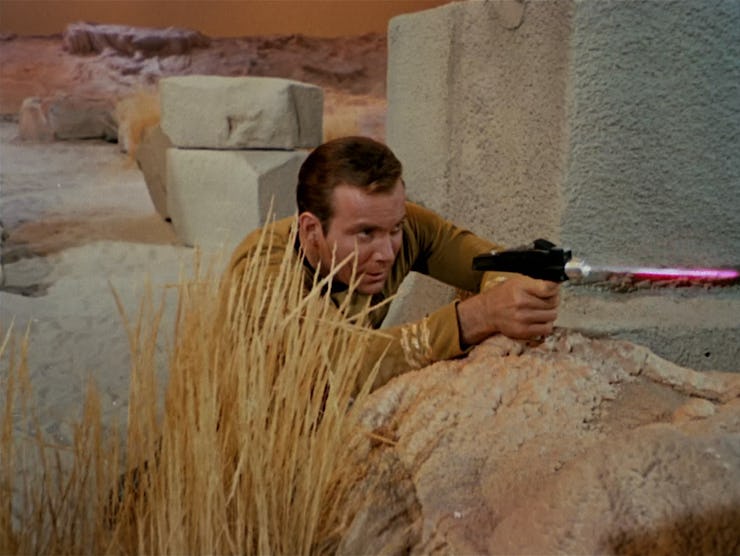
Captain Kirk is leaving his phaser on stun! In the first Star Trek: The Original Series episode to ever air — “The Man Trap” — the functionality of the famous Starfleet weapon, the phaser, is slightly different from what we see in the rest of the Trek franchise moving forward. As the world celebrates the 56th anniversary of Star Trek , let’s talk about the first zany appearance of the phaser.
Spoilers from 1966 ahead.
Although “The Man Trap” was the fifth installment of the regular series in terms of episode order (or the fourth, if you don’t count the second pilot), it was selected by NBC to be the first episode aired. This means that, on September 8, 1966 (and September 6 in Canada!) the world’s first glimpse of Star Trek was a thrilling episode in which a salt-sucking-shape-shifting monster terrorizes the crew of the Starship Enterprise .
As an introductory episode to the entirety of the Trek pantheon, “The Man Trap” is both a perfect and terrible representation of what The Original Series is. While Star Trek isn’t really a monster-of-the-week series, the twist in “The Man Trap” encourages the audience to have some sympathy for this salt vampire, even if it does put its gross suckers on Kirk’s (William Shatner) face.

Spock (Leonard Nimoy) messes with his phaser settings, while Kirk (William Shatner) thinks about how stunning he is.
Much of Trek’s internal continuity was still in flux in the first season of the series, which explains why Spock (Leonard Nimoy) doesn’t bother using the Vulcan nerve pinch on Nancy Crater (Jeanne Bal); at that point, the Vulcan nerve pinch hadn’t been depicted on screen yet. (Though it had been filmed for “The Enemy Within.”) But, space monster smackdowns aside, detailed-oriented Trek fans might notice something else unique about “The Man Trap”: The way the famous Trek phasers are used. Here, they stun Professor Crater (Alfred Ryder) in a way that is different from the rest of the classic show and the whole franchise.
When Kirk and Spock set out to apprehend Professor Crater on the surface of the planet M-113, Kirk tells Spock to set his phaser on “one quarter,” while Kirk leaves his “on stun.” The idea that phasers have all sorts of different levels isn’t that weird. Throughout the franchise, the technology is revealed to have gradients of power, including different kinds of “stun.” But what is weird is what happens when Kirk actually uses his phaser on Crater.
At the moment Crater is hit by Kirk’s phaser shot, we hear a unique sound effect, which many have described as sounding like a ricochet. This sound effect was never again used when someone was stunned with a phaser in The Original Series , nor on any other Trek series or film. It’s pretty cool, but it’s unique to “The Man Trap.”

This guy was stunned like nobody was stunned before, or since!
And if that wasn’t enough, when Kirk and Spock question Crater, right after the stunning, the voice of actor Alfred Ryder is slowed down to represent his post-stunned grogginess. As this deeper, slow-motion voice effect happens, he even stops himself and says, “Ooh! I feel strange.” And Kirk responds, “Just stunned. You'll be able to think in a minute.”
Although various complaints about the after-effects of being stunned have been referenced throughout the Star Trek canon by other characters, the ricochet in tandem with the slowed-down voice effect never happened again. In First Contact, Zefram Cochrane (James Cromwell) complains about a “hangover” from “your laser beam,” while in the Strange New Worlds episode “Spock Amok,” Number One (Rebecca Romijn) complains “Ow! that really stings.” But neither character speaks in slow motion.
In most of Trek canon, putting your phaser on “stun” effectively means putting your phaser on “tranquilize.” But, in “The Man Trap,” the stun setting actually means what it means. Crater is dazed and confused by the phaser, not rendered unconscious. For the most part, Star Trek never pivots back to this exact use of the phaser. Recently and notably, in Strange New Worlds , Number One and La’an (Christina Chong) have a brief phaser duel. Number One says to put the phasers on the “lowest setting,” which results in the phasers being set to “sting.” (Is there a “zing” setting?)
Although the exact in-universe effect of the phasers didn’t stick within the Star Trek canon, the nomenclature of giving a spacey weapon a non-lethal setting made a big impact. By the time the first Star Wars film dropped in 1977, sci-fi audiences were already primed to know what setting a weapon for “stun” meant. When those two stormtroopers decide they need to take Leia alive, they say “set for stun.”

Captain Pike (Anson Mount) with a phaser in Strange New Worlds.
Star Trek changed the face of science fiction and pop culture in ways that are perhaps innumerable. But, right at the very start, in the first episode that audiences saw, it also established a very specific and quirky way to diffuse conflicts.
The idea of setting a phaser on “stun” might seem like a nerdy reference; unpacking its functionality might seem like a way of getting way too in-the-weeds about Trekkie technology. But, within that narrative choice, the entire philosophy of Star Trek is made clear. Despite some of its more dated elements, one nice message of “The Man Trap” shines through, thanks to the phaser: there’s no need to mortally wound someone when you can just zap them instead.
The Star Trek franchise celebrates “Star Trek Day” on September 8 every year, which marks the first US airing of “The Man Trap.” You can watch that episode on Paramount+.

This article was originally published on Sep. 7, 2022
- Science Fiction
Phaser Technology
From star trek: theurgy wiki.
Phasers (an acronym for PHAS ed E nergy R ectification) were the most common and standard directed energy weapon in the arsenal of Starfleet and several other powers. Most phasers were classified as particle weapons and fire nadion particle beams. Based on the intensity and field of the beam and a variety of adjustments, a wide variety of effects could be achieved. All Starfleet phasers followed a similar naming convention, with the lowest being handheld and each higher number becoming more powerful and larger in size. After the Type-III, Phasers were too unwieldy to be hand operated and required such power that they were only suitable to be attached to vehicles, vessels, or outposts.
- 1.2.1 Type-II Pulse Phase Pistol
- 1.3.1 Type-III EVA Variant
- 2 Phaser Rifle Evolution
- 4.1 Type-IV Phaser Bank
- 4.2 Type-V Phaser Bank
- 4.3 Type-VI Phaser Bank
- 4.4 Type-VII Phaser Array
- 4.5 Type-VIII Phaser Array
- 4.6 Type-IX Phaser Array
- 4.7 Type-X Phaser Array
- 4.8 Type-XI Phaser Array
- 4.9 Type-XII Phaser Array
- 4.10 Type-XII Pulse Phaser Array
- 4.11 Type-U Pulse Phaser Cannon
- 4.12 Type-U+ Pulse Phaser Cannon
- 4.13 Type-I Rawley Heavy Pulse Phaser Cannon
- 5 Disclaimer Notice
Handheld Phasers
Utilized primarily in defensive situations, Handheld phasers had several applications, from use as a weapon to use as a cutting tool, explosive device, or energy source. Storing considerable energy, most phasers were distinguished by their size and firing capabilities, with all models able to output a focused energy discharge in the form of a beam or steady stream.
Colloquially know as the "Cricket", the type-I phaser was the smallest, most basic weapon carried by Starfleet and other Federation personnel. Easily concealable, the type-I was able to be programmed to fire automatically at set intervals. However, due to the lack of its operating capabilities, longevity, and diversity when compared to its larger brethren, the type-I phasers were typically only carried when it would be inappropriate to carry a larger weapon, such as on diplomatic missions. Because of this, the type-I was synonymous with secret missions and seldom seen in active use.
The type-II was the standard weapon used aboard all Starfleet vessels and bases, as it offered a very favorable compromise between size and power. Originally designed to encompass the type-I, the type-II held a pistol-like grip. By the 2360s, the type-II had evolved past that configuration, becoming a sleek, silver-colored device with a handle flowing into the form of a muzzle cowling and emitter. The type-II phaser was a required piece of equipment for most Starfleet away teams, and was the basic sidearm of Starfleet security teams
With two small buttons for beam width and intensity control and a large one to fire the device, the type-II featured a large, illuminated power level readout. The phaser retained the functionality of the previous designs, but increased the power and versatility. Like their predecessors, these units could be adjusted for use as cutting tools or power sources. They could also be set to overload, becoming a powerful explosive device.
In addition to more variable power settings than the Type-I, Type-II Phasers were able to be set for a "narrow" (affecting a single target) or "wide" beam (affecting two or more targets over a certain area). The frequency of the beam could also be adjusted to make it more effective against certain types of shields and/or force fields.
Type-II Pulse Phase Pistol
During the Dominion War , it became apparent that single beam particle weapons were ineffective against groups of Jem’Hadar. As such, Starfleet Security desired the ability to fire multiple short pulses of energy. The Type-III rifle was easily modified with a change of beam emitter, but due to the smaller size, the Type-II was unable to be modified in such a way.
With the need of a small weapon for use in close quarter situations, this handphaser variant Type-II Pulse Phase Pistol was created. Not only to be easily distinguishable between the conventional Type-II and this pulse fire variant, but to also account for an increased need for stability and accuracy, this new weapon took design elements of more traditional handheld weapons, incorporating a pistol-like grip and hard sight points along the top of the device.
Because of the difference in shape and fire pattern, Starfleet Personnel required further training on this weapon in addition to standard phaser profiency. As such, the type-II Pulse Phase Pistol was standardly reserved for Security and Tactical Conn personnel.
The largest standard phaser issued to Starfleet personnel, the Type-III (or simply referred to as the phaser rifle) was a two handed weapon capable of greater accuracy and longevity than its type-II counterpart. Even though the type-III had a much greater energy reserve, this only translated to an increase of longer periods of fire rather than any rise in output levels over one-handed phasers. Phaser rifles were not standard landing party equipment aboard Starfleet vessels. Typically, rifles were equipped only when firepower heavier than that of the type-II phaser was required.
Originally a bulky device with the capability of its rear handle to be rotated into a shoulder stock, the type-III was more streamlined and smaller by the 2360s. In the early 2370s, the need for accuracy caused the design aesthetic of the weapon to change once again, this time the rifle returned to having a shoulder stock but also incorporated a rear pistol-like and front under barrel grip, a combined sight and tactical light, and an integrated shoulder sling for ease of carrying.
The outbreak of the dominion war caused a need for weapons to fire in multiple bursts rather than just a single beam of energy. Starfleet Security created two new weapons for this purpose - the Type II Pulse Phase Pistol and the Type-III Phaser Compression Rifle. By 2375, the Compression Rifle was removed from service, due to comparable capabilities produced from the standard type-III with a change to its beam emitter. The switch between the angular and smooth beam emitters on the type-III rifles allowed the weapons to fire both single beam and pulses of energy at will by the operator.
After the completion of the dominion war, in the late 2370s, Starfleet Security updated the sights of the type-III to a red holographic style allowing for great accuracy and target acquisition. The integrated flashlight was unaffected.
Type-III EVA Variant
During the 2370s, Starfleet produced an additional variant of the type-III specifically designed for EVA missions. This rifle had unique features including, two pistol-like grips for ease of handling, no trigger guard to allow for use by personnel wearing EVA Suits , and magnetic areas allowing the rifle to be attached to a ship's hull.
This variant was later removed from service by Starfleet ; however, due to its popularity among officers, there were still many units available in the field. Before the acquisition of the Accipiter rifles Ryuan Sel , the Mistress-of-Arms of the USS Theurgy was known to prefer this weapon.

Phaser Rifle Evolution

All handheld Phasers used a common scale to denote the power output of the weapon, however, not all phasers could achieve the highest settings. Type-I Phasers were only able to reach settings 1-8, whereas type-II and type-III are able to make use of all sixteen.
Vessel-mounted Energy Weaponry
Directed energy weapons projected bolts or beams of focused energy or energized particles at a target. These weapons were commonplace, with most cultures having some form or another of directed energy weapon as the typical armament of their spacecraft, and they drew upon the abundant energy that starships generated. Energy weapons were composed of a type and a delivery method. Federation starships rarely used any other kind of directed energy weaponry than phasers. The delivery method of a phaser described how the emitters were arranged, and how the weapon was set-up to fire.
Cannons were close range, rapid-firing weapons that projected pulses or bolts of energy rather than consistent beams. These were inaccurate at longer ranges, but the volley of quick pulses could be devastating. Banks were a collection of emitters used early on by Starfleet , designed to fire in unison. They produced a focused beam of energy that could inflict considerable damage. Arrays were a more advanced technology, with long strips of linked emitters that shared a power feed, allowing the ship to fire from any point along the strip. This allowed the ship to fire in multiple directions at once, or to adjust and fire on moving targets repeatedly in quick succession.
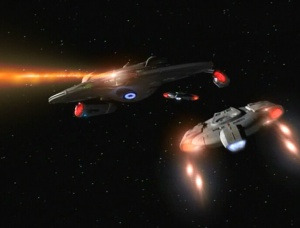
Originally, starships used phaser banks. Each bank contained one or more phaser emitters from which the beam energy was released. These systems shared common power sources and targeting systems. In the 2270s, phaser power systems of Federation starships were redesigned to channel power directly from the warp core, thereby increasing the power output of phaser banks.
By the 24 th century, the number of emitters in each bank had been increased to the point where they were laid out in long strips called phaser arrays. The arrays aboard a Galaxy-class starship could channel vast energy in a short time frame, capable of cutting through a mile of solid granite in seconds. Starship-mounted phasers were normally set to fire steady streams of phaser energies that would travel along the emitter strip and converge at the best position for targeting. Following the Battle of Wolf-359, Starfleet Engineers were also able to reconfigure the emitters in a different layout that allowed the phaser bank to rapid-fire as phaser cannons.
In addition to the powerful settings, the ship's phasers also had a stun setting that could be used to render lifeforms unconscious when fired at a planetary surface from orbit. It was also possible to configure starship phasers to also fire energy beams for power transfer.
There were many different type-of phasers mounted to starships. As new phaser technology became available, it was placed onto the ships being built at the time. Below are a few examples of phaser types mounted to various ship at the time of their initial construction.
Type-IV Phaser Bank
The smallest phaser bank currently deployed in the Federation , the Type-IV was markedly superior to the Type-III phaser rifle, providing more power, range, accuracy and adaptability. As such, it had been the workhorse of Starfleet 's auxiliary craft fleet for decades, as well as being mounted on a number of ground based vehicles. Only by 2381 is it being replaced by the Type-V array, a weapon of comparable simplicity but greater ability. It was not a very strong offensive measure but was capable of warding a small craft from many natural threats, such as asteroids and debris, and similar sized craft. Type-6 Shuttlecraft were known to operate with Type-IV Phasers.
Type-V Phaser Bank
A phaser bank generally found on small but high-powered Starfleet shuttlecraft, the Type-V was generally considered to be the next feasible replacement for the Type-IV array found on several thousand shuttles throughout the Federation . While not as powerful as the Type-VI or Type-VII, what it lacked in strength and longevity was more than made up for in its simplicity. Indeed, it rivalled even the modern Type-IV variant commonly found on shuttlecraft for ease of construction, maintenance and repair.
Type-VI Phaser Bank
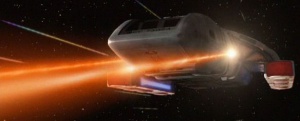
The second largest bank used on small craft such as runabouts, the Type-VI phaser bank was undeniably more powerful than its more dimunitive counterparts, with faster recharge rates, ranges and, of course, offensive capabilities, but lacked several of the advantageous maintenance and power factors found in its Type-VII fellow. Most remarkably, the Type-VI's increase in power over its smaller counterparts was less than the equivalent difference between it and the Type-VII, a characteristic explained by the (then) advanced techniques used in its construction and new methods of energy dissipation.
The Type-VI was not as commonly found as any of its counterparts, primarily due to the detailed work required in constructing it and the real but admittedly barely significant advantage in tactical situations it provided over the Type-V. It had, however, been found to be a suitable armament for some shuttlecraft, its intricate composition easily adaptable to some shuttles' requirements.
Type-VII Phaser Array
The largest emitter used on small craft such as runabouts and light escorts, the Type-VII phaser array was considerably more powerful than its more dimunitive counterparts, with faster recharge rates, ranges and, of course, offensive capabilities.
Recent advances in technology had allowed Starfleet to decrease the overall size of the Type-VII, thereby allowing it to be employed on vessels previously considered to be much too small to cope with the necessary machinery. As such, the Type-VII was markedly superior to the Type-VI phaser array but, due to practical issues, fell a bit short of the standard Type-VIII arrays being deployed on starships as of 2381.
Type-VIII Phaser Array
The Type-VIII was the phaser armament of choice for most of Starfleet 's small-to medium-sized ships. While varying degrees of power and capabilities could be found from class to class - even from ship to ship - the general Type-VIII operating principles remained the same and any deviations in any regard were usually negligible. This phaser type-provided excellent offensive and defensive capabilities for many ship classes that, due to their size, required significant quantities of internal volume for other operations which would otherwise be consumed by larger phaser weaponry.
Originally these weapons were installed in phaser banks aboard ships like the Excelsior-class and Constellation-class. Ships equipped with them as of 2381 were set in the standard array package. The only fighters that held dedicated Type-VIII phaser emitters were the AC-477 Mk I Valravn fighters, and those emitters were prototype-technology as of 2381, mounted on only twenty constructed fighters. On these fighters, the warp drive plasma conduit ran through the primary phaser coupling to double the power of the beams. It is as of yet unknown how the emitters would last in a prolonged engagement.
Type-IX Phaser Array
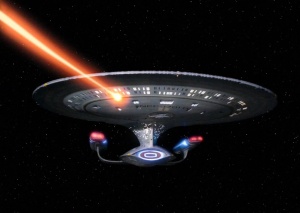
This was the armament of choice for many of Starfleet 's larger vessels and some of its medium-sized but patrol/combat-oriented craft. While bulkier and more complicated than its Type-VIII counterpart, the Type-IX provided excellent firepower with an impressive rate of fire that could only be bettered by Type-X, Type-XII or Type-U weapons.
Recent advances in weapons technology had allowed Starfleet to reduce the operating size for the Type-IX's components, allowing for this array to be employed as the new phaser weaponry of even refitted 23rd century starships.
Type-X Phaser Array
Until the development of the Type-XII, the Type-X was the heaviest weapon in use aboard Federation vessels, comprising the main armament of the Galaxy class starship. The Type-X had since seen its incorporation into other ship classes, providing significant firepower to some of Starfleet 's largest vessels. Galaxy and Intrepid-class vessels were originally fitted with Type-X Phasers.
Type-XI Phaser Array
Type-XI phaser was used normally for planetary defense. The emitters were designed to minimize atmospheric blooming of the beam. The phaser emitters in the carriages, embedded into the habitat ring of Deep Space 9 , were of this type, modified for use in space.
Type-XII Phaser Array
Previously designated as the 'Type-X+' for security reasons, the Type-XII phaser has been used in dedicated planetary defence arrays and as the main armament of heavy fortified starbases since 2363. It was considered that the Type-XII was unsuitable for use on a starship because the power requirements were too high and the support systems too bulky. However, by 2368 technical improvements had allowed for considerable shrinkage in the size of the equipment, and ship power systems had become capable of supporting the weapon. The main phaser armament of the new Sovereign-class starship therefore comprised Type-XII phaser arrays, as did the armament of the Prometheus -class. These are the most powerful phaser beam emitters currently in use by the Federation , the pulse phaser variant not withstanding.
Type-XII Pulse Phaser Array
This was the kind of phaser arrays that the USS Theurgy had installed, where there were two firing options available. Either beam emission or phaser pulse, depending on the situation. See Type-U below for more info on the pulse phaser kind of setting.
Type-U Pulse Phaser Cannon
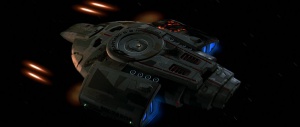
A relatively new development in phaser technology , the Type-U pulse phaser was the most combat-focused development of the phaser to date. It combined large, nearly flawless emitter crystals with rapid-discharge EPS banks and high-speed beam focusing coils. The system allowed the charge to be stored in the coils for a few nanoseconds, then released it as a layered pulse. Due to its nature, shields and armour had a harder time dispersing the pulse, resulting in more damage to the target. Pulse phasers were first deployed on the USS Defiant , where they managed to cause significant damage to Jem'Hadar fighters in a short space of time.
Type-U+ Pulse Phaser Cannon
This weapon worked on the same principles as the Type-U but at a much smaller scale as well as 40 % of the yield. It was an armament commonly found on the Federation 's fleet of fighters and a number of auxiliary craft. The first iteration of the U+ could be seen on either side of the AC-307 Mk II Valkyrie fighter, but a second version was made to be wing-mounted on the AC-409 Mk III Valkyrie . It was the same technology in both versions of the U+ cannons, only on the Mk III , the entire weapon system was mounted on the wings instead of being inside the fuselage of the fighter (as it is in the Mk II ). Furthermore, while the technology was the same, as an upgrade from the Mk II , the warp drive plasma conduit ran through the primary phaser coupling to increase the power of the Mk III ’s phaser cannons, giving it 50 % yield compared to the Type-U.
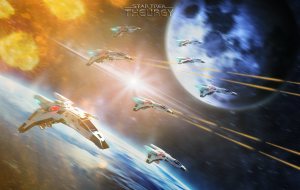
There were pulse or beam firing options available. Bolts had a firing rate of 5 per second. The beam setting had lower yield but longer range.
Type-I Rawley Heavy Pulse Phaser Cannon
Like the AC-409 Mk III Valkyrie 's wing-mounted pulse phaser cannons, the first and only iteration of the heavy Rawley cannon was also wing-mounted, and it demanded that the warp drive plasma conduit ran through the primary phaser coupling. Unlike the Type-U+, the Rawley cannon had a tendency to overheat during prolonged engagements, instead made for quick strikes and a mandatory cool-down period between such strikes. The benefit was that its yield was higher than the Mk III 's phaser cannons, at the lower firing rate of 3 bolts per second. Their yield was approximately 60 % of the Type-U pulse phaser cannons.
The Rawley cannons did not have a beam firing option available, and they were mounted as standard armament on the AC-347 Knight-class Interceptor . After the refit of the SS Sabine NX-59846 , it also had two of these cannons mounted underneath its wings.
Disclaimer Notice
Some info on Vessel-mounted Phasers used with permission of USS Wolff CO - granted Jan 30, 2017
- Technical Specifications
- Starfleet Information
85 episodes
Rising from the destruction on Veridian III, the USS "Future Imperfect" is rechristened as "Altered Trek". A podcast covering the episodes, series, the science, the content, and the concepts that are Star Trek. Join Trek fanboy Steve Megatron, and casual watcher TFG1Mike as we discuss all things Star Trek.
Altered Trek GeekCast Radio Network, LLC
- TV & Film
- JAN 21, 2024
The Re Introduction Of Our Hosts And Setting Phasers To Fun!
In Episode 086 of Altered Trek join Admiral Phillips and TFG1Mike as they rebrand Future Imperfect to Altered Trek, and give you a brief breakdown of what this GCRN Star Trek podcast will be all about as they endeavor to engage the Star Trek they enjoy! As always Live Long, and Prosper! And Make It So! GCRN Universal Ratings System! Use TFG1Mike's LinkTree to Follow Him!! Follow Steve/Megatron on X and Threads! Send Us Email HERE!
- AUG 1, 2021
Favorite Episodes of The Next Generation, Season 2
In this episode of "Future Imperfect," Admiral Phillips returns with Birdman and Alex from ThisWeekinGeek and Aaron Pollyea dig deep and discover their favorite must-watch episodes of Star Trek: The Next Generation - Season 2. Listen in to find out what those are and what they plan to discuss next. Live Long, and Prosper!
- MAR 2, 2021
Favorite Episodes of The Next Generation, Season 1
Mike, Steve, Alex, and Aaron dig deep and discover their favorite must-watch episodes of Star Trek: The Next Generation - Season 1. Listen in to find out what those are and what they plan to discuss next. Live Long, and Prosper.
- 1 hr 14 min
- JAN 19, 2021
Reviewing Discovery S3, Episodes 10-13
In this episode of "Future Imperfect," Admiral Phillips returns with Birdman and Alex from ThisWeekinGeek and Aaron Pollyea to discuss Star Trek Discovery Season 3, Episodes 10-13! Trainwreck aside, we're glad it's over...for now. Next time, we get to explore favorite episodes of TNG Season 1. All this and more on Future Imperfect!
- JAN 9, 2021
Reviewing Discovery S3, Episodes 5-9
In this episode of "Future Imperfect," Admiral Phillips returns with Birdman and Alex from ThisWeekinGeek and Aaron Pollyea to discuss Star Trek Discovery Season 3, Episodes 5-9! The Good, The Bad, The Ugly. All this and more on Future Imperfect!
- NOV 22, 2020
Reviewing Discovery S3, Episodes 1-4
In this episode of "Future Imperfect," Admiral Phillips returns with Birdman and Alex from ThisWeekinGeek and Aaron Pollyea to discuss Star Trek Discovery Season 3, Episodes 1-4! The Good, The Bad, The Ugly. All this and more on Future Imperfect!
- 1 hr 31 min
- Copyright © 2023 GeekCast Radio Network, LLC
Top Podcasts In TV & Film
More by the geekcast radio network.
- More to Explore
- Series & Movies
Published May 16, 2024
The Baddest Part of Space: A Brief History of the Badlands
The last place in the galaxy you want to take your starship, is often the place with the most going on.
SPOILER WARNING: This article contains story details and plot points for Star Trek: Discovery Season 5's "Erigah" and "Labyrinths"!

StarTrek.com
The stormiest part of the galaxy is also the place where everyone seems to end-up, at least, if you’re in a certain kind of Star Trek adventure.
In the seventh (" Erigah ") and eighth ("Labyrinths") episodes of Star Trek: Discovery Season 5, the crew learns that the final clue to unlocking the Progenitor tech will lead to the Eternal Gallery and Archive, a kind of mobile library. These days, it's located in the center of the Badlands , an area of space beset with plasma storms, gravitational anomalies, and, on a few occasions, the accidental doorway to the other side of the galaxy.
Discovery 's return to the Badlands might be the next-to-last stop on the treasure map to get the elusive secrets of the Progenitor tech, but it's a thrilling moment for longtime Star Trek fans. The Badlands isn't just a random Easter egg. This is a part of space pivotal to the history of the 24th Century, a place which spans not just a chunk of the Alpha Quadrant, but the paths of two beloved Trek shows — Star Trek: Deep Space Nine and Star Trek: Voyager .
Here's your brief history of the Badlands, plus, what makes it so bad, and so cool.
Star Trek and the Art of Foreshadowing
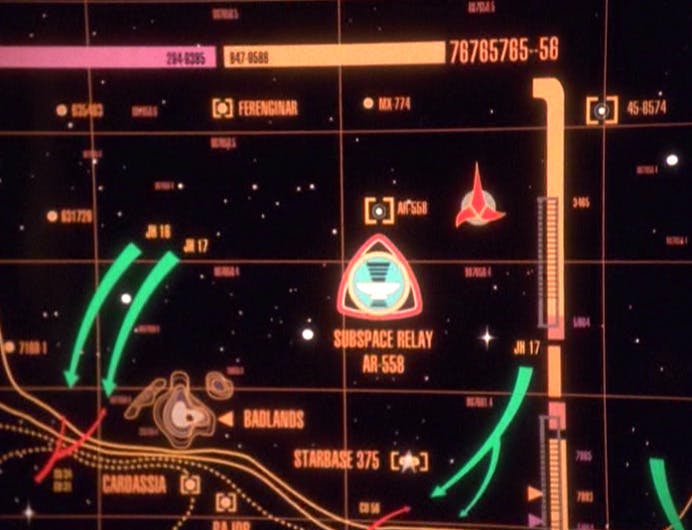
"When It Rains..."
In many ways, the Badlands represents a moment in Star Trek history where the franchise was getting really good at planting seeds for later plot developments, and, in the case of the Badlands, for TV series that had yet to even premiere. As many longtime fans know, back in the 1990s, having serialized arcs on any TV show was rare, meaning that ongoing shared continuity between Star Trek: The Next Generation and Deep Space Nine was downright revolutionary.
How does this connect to the Badlands? Well, before the U.S.S. Voyager actually went into the Badlands in the 1995 series premiere of Star Trek: Voyager , " Caretaker ," the concept of the Badlands was introduced in Deep Space Nine .
On April 24, 1994, in the 20th episode of Deep Space Nine 's second season, the concept of the Badlands was quietly introduced. Titled " The Maquis, Part I ," the episode introduced the growing resistance movement among former Federation colonists living in a demilitarized zone that now was part of Cardassian space. This storyline was directly connected to The Next Generation episode " Journey's End ," which had aired just a month prior on March 28, 1994. That episode established the conundrum of what was happening to the Federation colonists in the Cardassian DMZ, and then, DS9's "The Maquis, Part I" and " The Maquis, Part II ," revealed what happened when those colonists organized into a fighting force.
By May 16, 1994, this storyline pivoted back to TNG with the episode " Preemptive Strike ," in which Ro Laren defects to the Maquis, breaking Captain Picard's heart for nearly 30 years, until their reconciliation in the 2023 episode of Star Trek: Picard , " Imposters ."
So, in 1994, the Star Trek franchise escalated a huge storyline in March, April, and May. And one common element of this entire Maquis storyline was the Badlands.
The Badlands Revealed
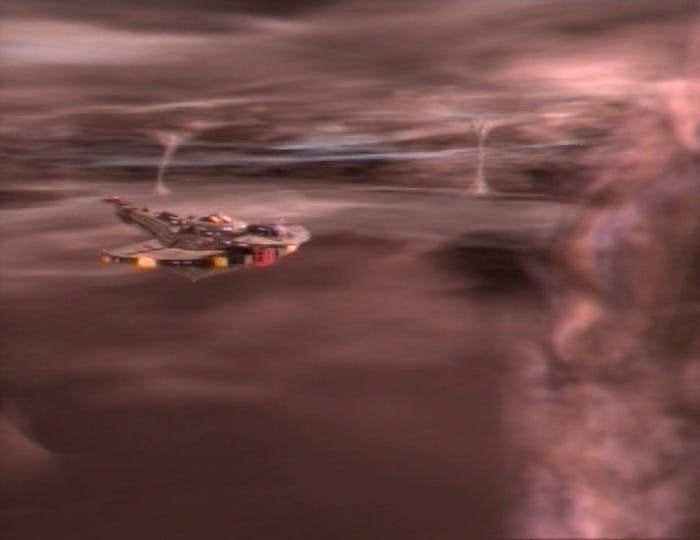
"Caretaker"
Although Deep Space Nine introduced the concept of the Badlands in Season 2, and later mentioned it again in the Season 3 episode " Defiant ," the full destructive and absurdly dangerous aspect of the Badlands wasn't fully on display until the first episode of Star Trek: Voyager .
In "The Maquis, Part 1," Sisko says, "A few ships have been lost there over the past year or two," which again, foreshadows the moment when Voyager, and then Chakotay's ship the Val Jean , are transported to the Delta Quadrant, from the Badlands.
So while the Badlands had been visited and name-checked before Voyager , most fans associate this unstable region of space with that series. And with good reason, if Voyager had never pursued the Val Jean into the Badlands, the entire show would never have happened. Janeway even selected the temperamental, former-criminal Tom Paris as her pilot, because the Badland were known to be treacherous. And although DS9 would revisit the Badlands a bit more in subsequent seasons, the pink-orange landscape of the plasma storms from the opening moments of "Caretaker" have been burned into the brains of fans for almost 30 years.
Discovery ' s Return to the Badlands
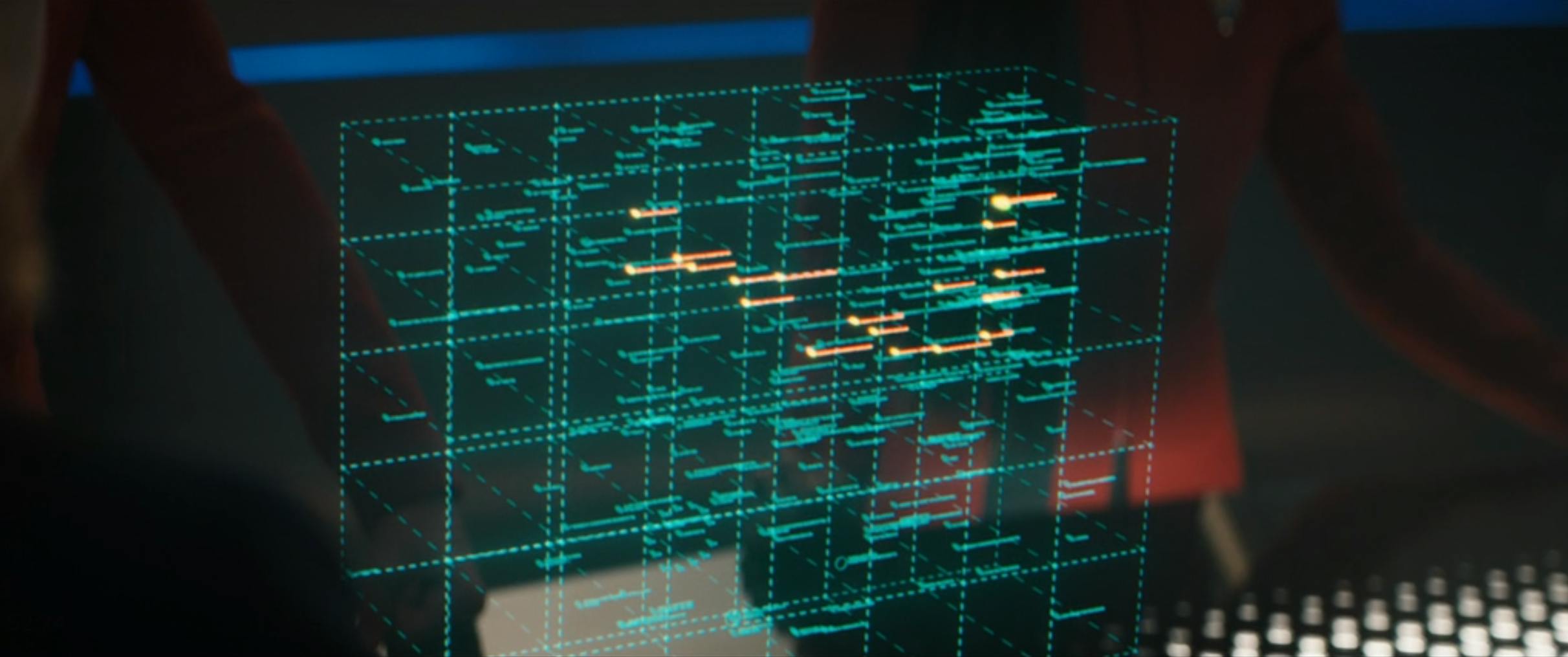
"Erigah"
As Rayner tells Captain Burnham in "Erigah," he’s been to the Badlands and "it's as fun as it sounds." In "Labyrinths," we learn what was a very unstable region in the year 2371, has expanded to become, as Rayner explains, "the largest plasma storm in the quadrant," in 3191.
When Discovery enters the Badlands, it appears to be one intricate, massive storm in space, even more intense than back in the Voyager days. "It's kinda beautiful, in a twisted sort of way," Tilly declares as the ship rolls up on the Badlands, and she's totally right.
While the Badlands has always been a scary place in the Trek universe, there's also something ethereal and magical about this specific spacescape. In DS9, it was a place of refuge for an idealistic band of rebels. In Voyager , the Badlands became a doorway to a larger adventure, changing the lives of Janeway and the rest of the crew in ways that had countless repercussions throughout all of Star Trek history. And now, in Discovery , the Badlands becomes a diaphanous, whimsical setting for a library in space.

"Labyrinths"
One of Star Trek 's recurring themes is the ways in which the pursuit of knowledge can help us all overcome hardship. And in Discovery , that theme is perfectly exemplified by a celestial library, at the center of an interstellar storm.
Get Updates By Email
Ryan Britt is the author of the nonfiction books Phasers on Stun! How the Making and Remaking of Star Trek Changed the World (2022), The Spice Must Flow: The Journey of Dune from Cult Novels to Visionary Sci-Fi Movies (2023), and the essay collection Luke Skywalker Can’t Read (2015). He is a longtime contributor to Star Trek.com and his writing regularly appears with Inverse, Den of Geek!, Esquire and elsewhere. He lives in Portland, Maine with his family.
Star Trek: Discovery Seasons 1-4 are streaming exclusively on Paramount+ in the U.S., the UK, Canada, Switzerland, South Korea, Latin America, Germany, France, Italy, Australia and Austria. Seasons 2 and 3 also are available on the Pluto TV “Star Trek” channel in Switzerland, Germany and Austria. The series streams on Super Drama in Japan, TVNZ in New Zealand, and SkyShowtime in Spain, Portugal, Poland, The Nordics, The Netherlands, and Central and Eastern Europe and also airs on Cosmote TV in Greece. The series is distributed by Paramount Global Content Distribution.
- Star Trek 101
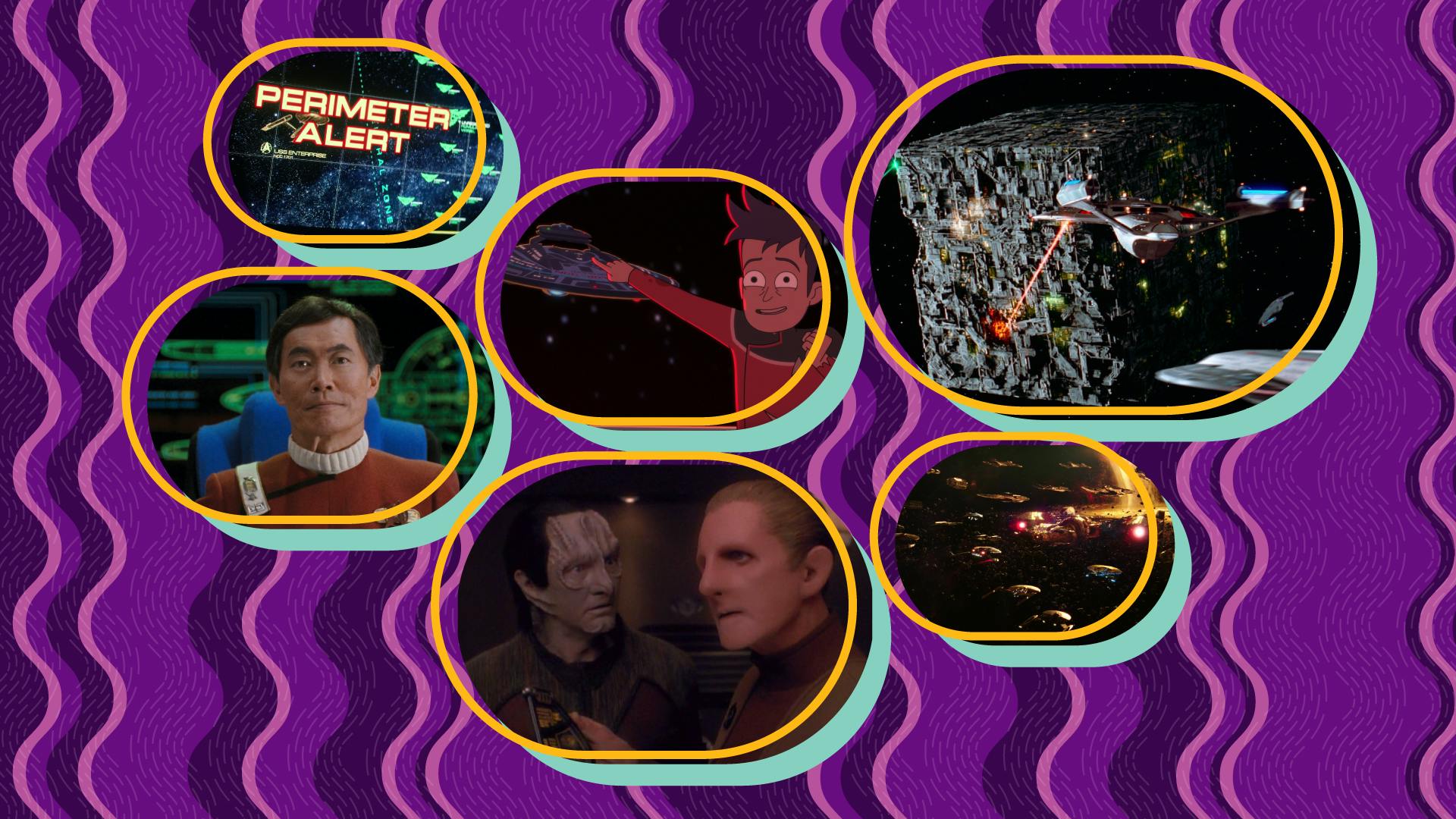

Dailymotion
10 Star Trek Legends Who Starred In Horror Movies
Posted: May 16, 2024 | Last updated: May 16, 2024
Set phasers to scream! Star Trek icons in horror movies.
More for You
Alvin Bragg Announces New Indictment
Selena Gomez Makes a Head-Turning Cannes Entrance in Custom Oscar de la Renta
15 of the Most Heartbreaking Tragedies in Classic Rock History
Stefanik, Fox News host clash over question about Trump
16 Popular Pizza Chains, Ranked Worst to Best
Jalen Brunson had a 1-word answer to sum up his feelings on the Knicks losing Game 7
What not to throw out when decluttering — cleaning pros spill on the 7 things you should keep hold of
‘Fresh Prince’ star Alfonso Ribeiro says show ‘became a sacrifice’ that ended his acting career
10 Fighter Jets You Can Actually Buy (And How Much They Cost)
Neurodivergent employees aren’t disclosing their conditions at work because they worry it will hurt their career
A Tasty Burger: The Best Fast Food Burgers (And 9 Places To Skip the Beef)
Basketball player collapses mid-game
Ukrainian Navy tells if Russia deployed missile carriers at sea
You're Weighing Yourself Wrong. Here's When and How to Do It Right
Marco Rubio clashes with Kristen Welker over accepting the 2024 election results
The Surprising Name Origins of 20 Famous 1980s Bands
The Common Household Ingredient That Can Unclog Slow-Draining Sinks And Tubs
20 Best Sandwiches in America You Need to Try At Least Once
‘We are in the process of sending NASA our claim’: Space junk smashed into a Florida man’s home and caused over $15K in damages — does insurance have to pay for it?
Elon Musk Reverses Layoffs, Rehires Supercharger Team Members

IMAGES
VIDEO
COMMENTS
(Star Trek Into Darkness) Two phasers set on setting one fired simultaneously could break large objects into pieces, such as the urns of the second planet of the Taurean system. (TAS: "The Lorelei Signal ") Setting 3.1 was enough to cause a Changeling to experience the stun effect. Setting 3.4 or 3.5 was determined to be a stun setting that ...
Settings. # setting description. 1 Light Stun 50 pts. non-lethal (n-l) damage, subject will be unconscious for about a minute and semi-conscious for 1D4 minutes more. 2 Stun 75 pts. n-l, subject is unconscious for 4 + 1D6 minutes. 3 Heavy Stun 120 pts. n-l, subject is unconscious for 30 + 3D10 minutes.
Star Trek: First Contact (1996) Star Trek's phasers have taken many shapes and sizes throughout its six-plus decades, from the tiny "cricket" seen in Star Trek: The Next Generation to the very large and powerful ones on the Enterprise. They have also had a lot more functions and settings that just "stun" and "kill."
A beam setting was the amount of discharge given-off by a directed energy weapon, such as phase-pistols, plasma rifles, phasers, or disruptors. It was similar in concept to the variable yield capability used on torpedoes. When Spock, Data, and Jean-Luc Picard outmaneuvered Sela in her office, Spock held a captured Romulan disruptor to her and warned her "I'm afraid I don't know too much about ...
In each Star Trek series, Starfleet crews primarily use hand phasers. The Type-1 phaser is a small handheld device capable of various settings, including numerous degrees of stun, kill, and heat ...
This is the level that a phaser can start to penetrate certain types of forcefield. 6-7 Are killing levels, essentially shocking the target's body into shutting down. Anything higher than this vaporize/explode certain things, ranging from people on setting 8 to large chunks of rock on the higher end. Reply reply. ElectricPeterTork.
"SET PHASERS TO STUN" It was established early on in Star Trek: The Original Series that the phasers used by the > crew of USS Enterprise had a "stun" setting (as mentioned in "The Man Trap" episode), and both Kirk and Spock often found themselves instructing their crewmates to use the non-lethal capabilities of their standard-issue ...
Landing party will pick up phaser number ones from the arsenal. Keep them inconspicuous.James T. Kirk A type-1 phaser was the smallest, most basic weapon carried by Starfleet and other Federation personnel. Type 1 phasers were typically carried when it would be inappropriate to carry a larger weapon, such as on diplomatic missions, or "undercover" work. The type 1 had eight adjustable settings ...
Addressing "How does a phaser change from Stun to Kill?" The Star Trek the Next Generation Technical (isbn -671-70427-3) Manual covers the power settings. The differences in the settings are based on power output and duration, as well as SEM (Simple Electro-Magnetic) and NDF Nuclear Disruption Force ratios.
Step into the world of Star Trek phasers and uncover the subtle differences that distinguish the originals from replicas. From paint matches to machining, le...
Phasers have the same effect at maximum power setting but have the ability to use lower settings that have different effects, from heating objects, to stunning living orgasnisms. Phasers also seem less effective against heavy dense metals such as duranium used by the Cardasians and seem almost useless against monotanium used by the Hirogen.
#startrek #phasers #technology Phasers are one of the most iconic pieces of technology from Star Trek. Powerful particle weapons with settings ranging from a...
The Weapon Of Starfleet. In terms of their destructive power, as phasers are used mainly as weapons, they are capable of a wide variety of things. On a low setting, they can be used to stun ...
In Star Trek VI: The Undiscovered Country, Lt. Valeris (Kim Cattrall) reminded the crew that no one may fire an unauthorized phaser aboard a starship because it signals a red alert. In addition, firing a phaser set to stun at close range has proven to kill a target. When the TNG and J.J. Abrams' Star Trek films focused more on being action ...
When the first 'Star Trek' episode aired on September 8, 1966, the way phasers worked was very different. Let's unpack those stunning phasers in "The Man Trap." ... The idea of setting a phaser on ...
Starship-mounted phasers were normally set to fire steady streams of phaser energies that would travel along the emitter strip and converge at the best position for targeting. Following the Battle of Wolf-359, Starfleet Engineers were also able to reconfigure the emitters in a different layout that allowed the phaser bank to rapid-fire as ...
Phasers are common and versatile phased array pulsed energy projectile weapons, first seen in the original Star Trek series and later in almost all subsequent films and television spin-offs. Phasers range in size from small arms to starship-mounted weaponry.. Though they seem to discharge in a continuous "beam", close observation reveals that phasers actually discharge a stream of pulsed ...
Answers for phaser setting in star trek crossword clue, 4 letters. Search for crossword clues found in the Daily Celebrity, NY Times, Daily Mirror, Telegraph and major publications. Find clues for phaser setting in star trek or most any crossword answer or clues for crossword answers.
There are 16 settings on a phaser, according to the Star Trek Next Generation Technical Manual. Settings 1-3 are light to heavy stun, 5-6 are burn, 7 is kill instantly, and 8 is vaporizing organic matter, which is normally called maximum. 9-12 are for vaporizing things like rock, or metal. 13-16 are self destruct settings, and have the power of ...
The Crossword Solver found 30 answers to "star trek phaser setting", 4 letters crossword clue. The Crossword Solver finds answers to classic crosswords and cryptic crossword puzzles. Enter the length or pattern for better results. Click the answer to find similar crossword clues . Enter a Crossword Clue. Sort by Length. # of Letters or Pattern.
Setting a phaser on overload. In the original series, it was mentioned several times that a hand phaser could be set to overload, turning it into a makeshift hand grenade. There was one episode, for example, where someone tries to assassinate Captain Kirk by setting a phaser on overload and hiding it in his quarters, hoping to blow him up.
TNG tech manual said there are 16 levels of phaser settings with only 1-3 being "stun" after which it proceeds through Thermal Effects, then Disruption Effects, then Explosive Effects. ... I can't think of a time on Star Trek when they set phasers to kill things that they could've easily stunned. I can remember times they needed max power ...
The Re Introduction Of Our Hosts And Setting Phasers To Fun! In Episode 086 of Altered Trek join Admiral Phillips and TFG1Mike as they rebrand Future Imperfect to Altered Trek, and give you a brief breakdown of what this GCRN Star Trek podcast will be all about as they endeavor to engage the Star Trek they enjoy! As always Live Long, and Prosper!
Also, for comparison, p. 135 of the published version of the technical manual says this about the effects of high and low phaser settings: As with the ship's main phasers, the greater the energy pumped into the prefire chamber, the higher will be the percentage of nuclear disruption force (NDF) created.
In many ways, the Badlands represents a moment in Star Trek history where the franchise was getting really good at planting seeds for later plot developments, and, in the case of the Badlands, for TV series that had yet to even premiere. As many longtime fans know, back in the 1990s, having serialized arcs on any TV show was rare, meaning that ongoing shared continuity between Star Trek: The ...
Set phasers to scream! Star Trek icons in horror movies. The Coolest Car From the Year You Were Born (1945-1995) 7 Ways People Destroy the Value of Their Homes, According to a Real Estate Agent ...